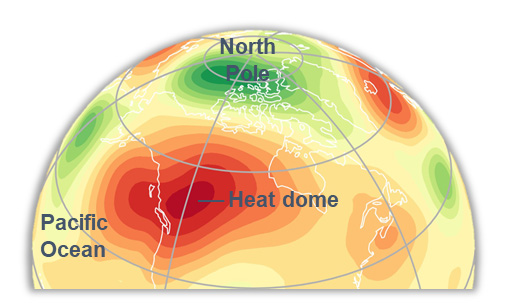中国科学院大气物理研究所大气科学和地球流体力学数值模拟国家重点实验室
State Key Laboratory of Numerical Modeling for Atmospheric Sciences and
Geophysical Fluid Dynamics (LASG)
Institute of Atmospheric Physics, Chinese Academy of Sciences
State Key Laboratory of Numerical Modeling for Atmospheric Sciences and
Geophysical Fluid Dynamics (LASG)
Institute of Atmospheric Physics, Chinese Academy of Sciences

Vol.19/No.19 December 2023
NC: 2021-Like North American Heat Extremes: Increased Impact of Heat Domes due to Background Warming and Soil Moisture Feedback
"The impact of heat domes on North American heat extremes is expected to increase due to background warming and soil moisture feedback", according to a recent study published in Nature Communications on March 27.

The heat dome at 500 hPa (Image by ZHANG Xing)
This research was led by Prof. ZHOU Tianjun from the Institute of Atmospheric Physics at the Chinese Academy of Sciences. The team found that the heat dome-like atmospheric circulations over Western North America contributed over 50% of the magnitude of the observed high temperature. The study revealed that the intensities of 2021-like North American heat extremes have already been impacted by heat domes and will continue to increase due to both the background warming and soil moisture feedback. These findings highlight the urgency and importance of taking action to mitigate the effects of heat domes and address the underlying causes of heatwaves.
"We examined the long-term changes in extreme temperature and heat dome-like atmospheric circulation in the observations. While the temperature index exhibits an accelerated warming trend since 1990, no similar trend is seen in the evolution of a heat dome-like circulation index. This indicates that the hot extreme associated with global warming could increase faster than atmospheric circulation", said ZHANG Xing, the first author of the study, a Ph.D student from the University of the Chinese Academy of Sciences.
"To reveal the underlying physical reasons, we investigated the changes of soil moisture and found strong feedback to heat extremes. The soil moisture-atmosphere feedback partly explains why the intensities of hot extremes associated with similar heat domes increase faster than background global warming", explained Prof. ZHOU Tianjun, the corresponding author of the study.
The scientists extended their study to future climate projections. It is found that the frequency of similar heat events will increase by 40-fold by the end of the 21st century compared to that in 2021 under the RCP8.5 scenario (a business-as-usual scenario).
"To mirror the policy discourse surrounding the Paris Agreement targets of 1.5 °C and 'well below 2 °C', we also assessed changes at global warming levels of 1.5 °C, 2 °C and 3 °C. We found that if we limit global warming to 1.5 °C instead of 2 °C (3.0 °C), the 0.5 °C (1.5 °C) less warming would reduce the population exposures to 2021-like heat extreme in Western North America by ~53% (89%) under the RCP8.5-SSP5 scenario. This has important implications for climate mitigation and adaptation activities”, said Dr. ZHANG Wenxia, co-author of the study.

The distribution of the maximum temperature anomalies under heat dome-like (Analogs) and random (Control) circulation. The numbers represent the contribution of circulation, and the red line indicates the maximum temperature anomalies of 2021 North America heatwave. (Image by ZHANG Xing)
Citation: Zhang Xing, Tianjun Zhou*, Wenxia Zhang, Liwen Ren, Jie Jiang, Shuai Hu, Meng Zuo, Lixia Zhang & Wenmin Man, 2023: Increased impact of heat domes on 2021-like heat extremes in North America under global warming. Nature Communications 14, 1690 (2023). https://doi.org/10.1038/s41467-023-37309-y
Link: https://www.nature.com/articles/s41467-023-37309-y
Contact: ZHOU Tianjun, zhoutj@lasg.iap.ac.cn
Add: No.40, Huayanli, Beichen West Road, Chaoyang District, Beijing P.O. Box 9804, 100029, China
E-mail: lasg_newsletter@lasg.iap.ac.cn
Editors: Chuanyi Wang (wangcy@lasg.iap.ac.cn), Kangjun Chen(ckj@lasg.iap.ac.cn)
E-mail: lasg_newsletter@lasg.iap.ac.cn
Editors: Chuanyi Wang (wangcy@lasg.iap.ac.cn), Kangjun Chen(ckj@lasg.iap.ac.cn)